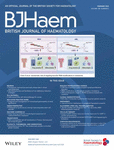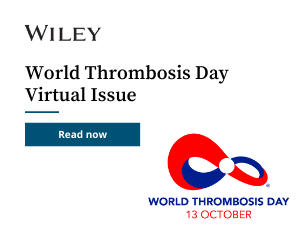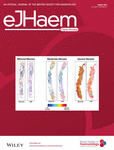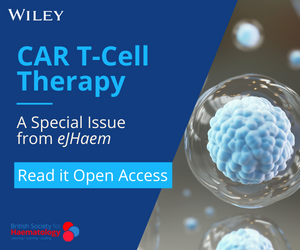Journal list menu
Export Citations
Download PDFs
Issue Information
IMAGES IN HAEMATOLOGY
A monstrous relapsed hairy cell leukaemia with large cells
- Page: 409
- First Published: 25 November 2024
Aggressive NK-cell leukaemia: Diverse morphology, distinct clinical features
- Pages: 410-411
- First Published: 25 November 2024
Concomitant HIV-associated plasmablastic lymphoma and visceral leishmaniasis at initial presentation
- Pages: 414-415
- First Published: 12 January 2025
REVIEW
A blueprint for pursuing therapeutic interventions and early phase clinical trials in clonal haematopoiesis
- Pages: 416-427
- First Published: 09 December 2024
An approach to Hemequity: Identifying the barriers and facilitators of iron deficiency reduction strategies in low- to middle-income countries
- Pages: 428-442
- First Published: 06 January 2025
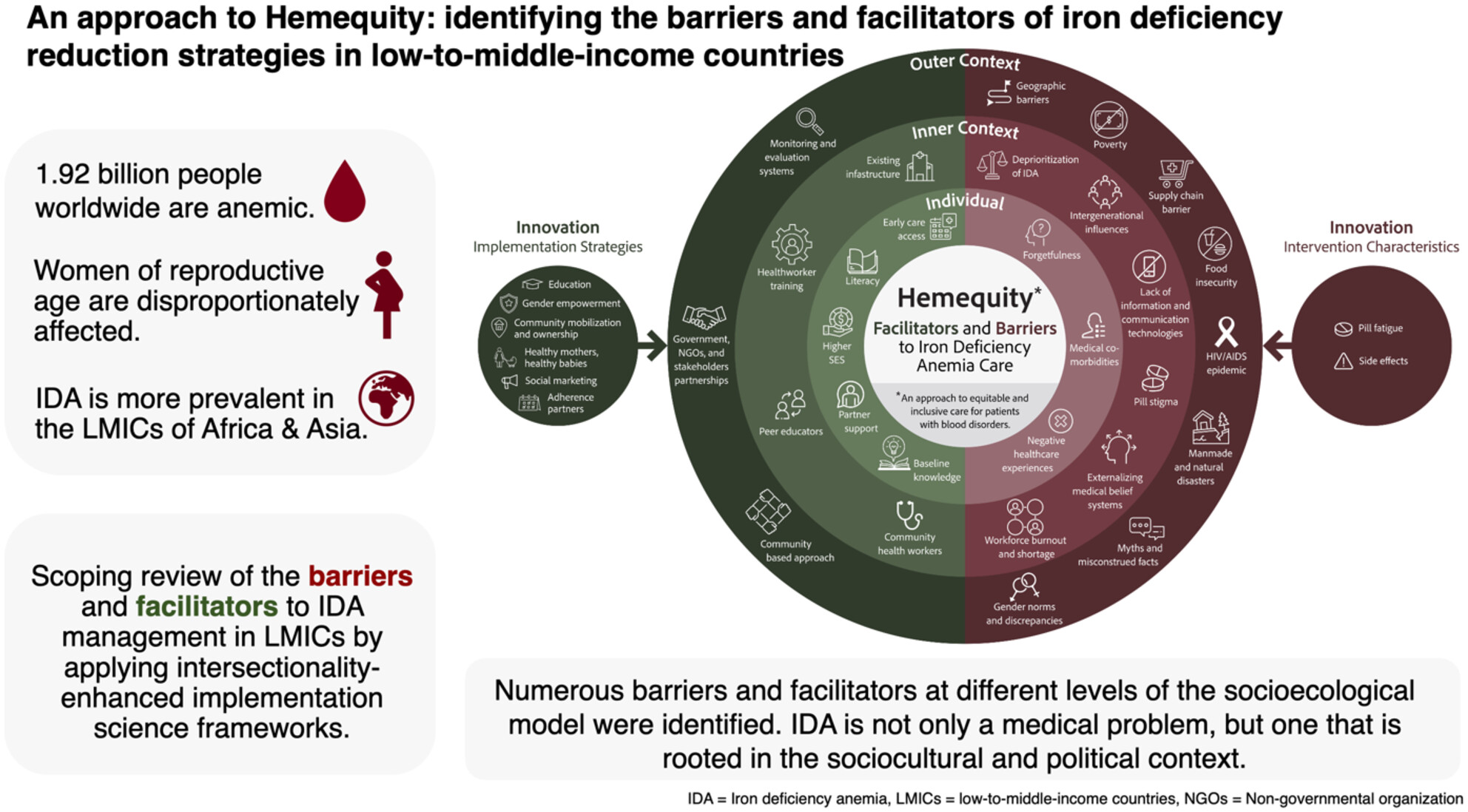
Iron deficiency anaemia (IDA) disproportionately affects women of reproductive age and remains under-addressed in low- to middle-income countries (LMICs). The primary objective of our scoping review is to evaluate the barriers and facilitators to IDA management in LMICs by using an intersectionality-enhanced implementation science lens. Our results highlight that IDA is not only a medical problem, but one that is rooted in the sociocultural and political context. Future approaches must recognize the resilience of LMIC communities and acknowledge the importance of knowledge translation rooted in community ownership and empowerment.
IN A NUTSHELL
Advances and challenges in chimeric antigen receptor-natural killer cell immunotherapy for cancer
- Pages: 443-446
- First Published: 02 December 2024
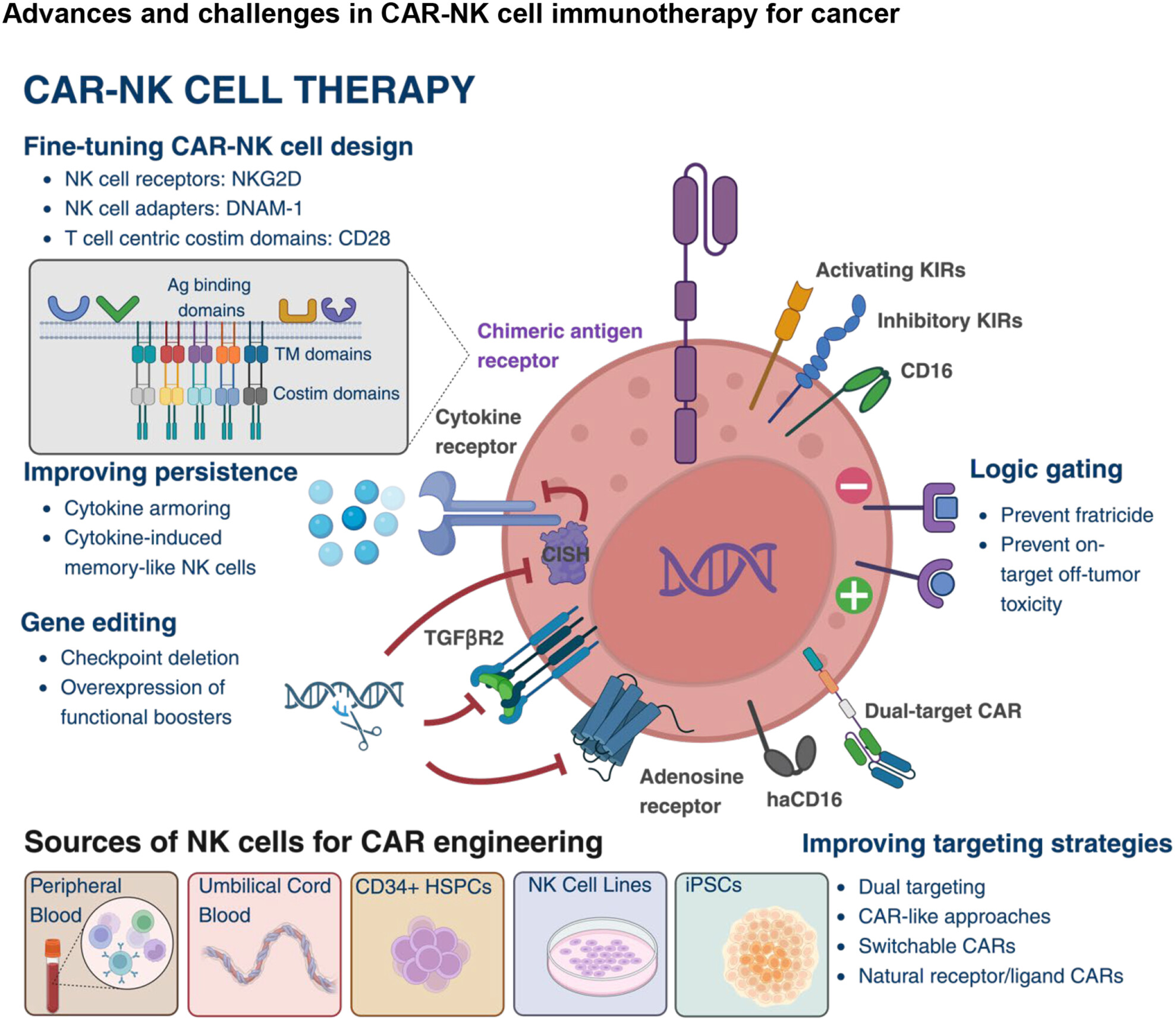
CAR-NK cell therapy is an emerging immunotherapy for cancer. Recent advancements in genetic engineering have improved their antitumour efficacy through strategies such as dual-targeting CARs, cytokine armouring and logic gating to minimize fratricide and off-target effects. Gene-editing approaches, including checkpoint deletion and overexpression of key effector molecules, further enhance their persistence and cytotoxicity. Additionally, the availability of diverse NK cell sources, such as peripheral blood, umbilical cord blood, CD34+ haematopoietic stem and progenitor cells, and iPSCs, offers scalability and flexibility for clinical applications. These innovations position CAR-NK cells as a versatile and potent therapeutic platform for treatment-resistant malignancies.
BSH GOOD PRACTICE PAPER
Good Practice Paper
Diagnosis and management of monoclonal gammopathy of renal significance: A British Society for Haematology good practice paper
- Pages: 447-463
- First Published: 07 January 2025
WIDER PERSPECTIVES
Haemoglobinopathies
Reframing thalassaemia syndrome as a benign haematopoietic stem cell disorder
- Pages: 464-477
- First Published: 15 December 2024
SHORT REPORT
Biology and Translational Science
CD71+ erythroid cells promote multiple myeloma progression and impair anti-bacterial immune response
- Pages: 478-483
- First Published: 20 November 2024
ORIGINAL PAPER
Biology and Translational Science
Distinct subtypes of post-transplant lymphoproliferative disorders: CHIP-like mutations in early lesions and substantial mutational differences between EBV-positive and EBV-negative diffuse large B-cell lymphomas
- Pages: 484-504
- First Published: 07 January 2025
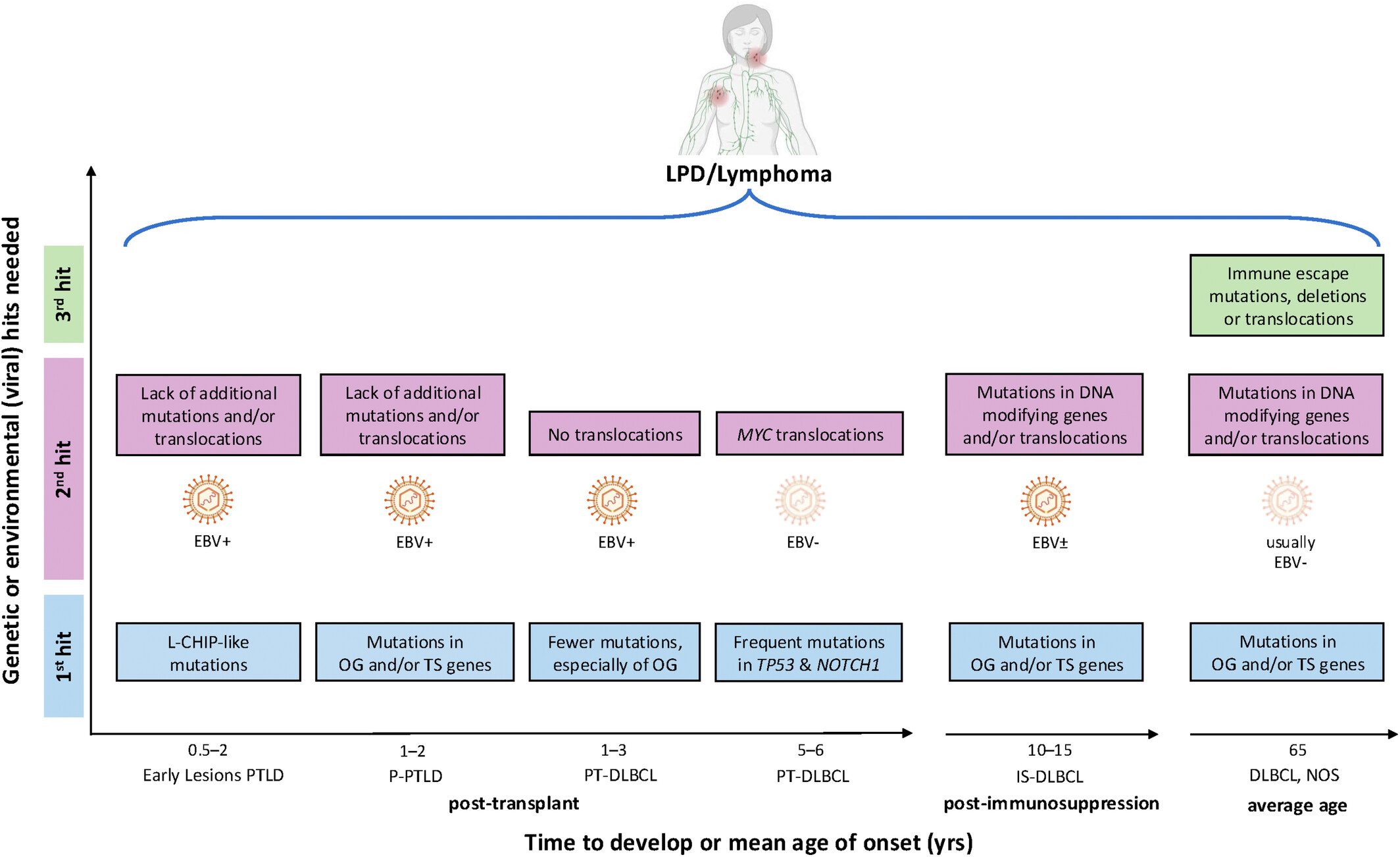
Current mechanisms of lymphomagenesis, which require at least two and/or three genetic ‘hits’ leading to the development of lymphoproliferative disease (LPD) or lymphoma. The mechanisms are shown for ‘early lesions’ post-transplant LPD (PTLD), including infectious mononucleosis (IM-), follicular hyperplasia (FH-) and plasmacytic hyperplasia (PH-) PTLDs, polymorphic (P-) PTLD, post-transplant diffuse large B-cell lymphoma (PT-DLBCL), as well as DLBCL with autoimmune/immunocompromised backgrounds (IS-DLBCL) and DLBCL, not otherwise specified (NOS). The timeline highlights the difference in time to develop PTLD, IS-DLBCL and DLBCL, NOS after transplantation, after the start of immunosuppression or the average age for the disease onset, respectively. L-CHIP, lymphoid clonal haematopoiesis of indeterminate potential; OG, oncogene; TS, tumour suppressor.
HOPX as a tumour-suppressive protein in T-cell acute lymphoblastic leukaemia
- Pages: 505-516
- First Published: 30 December 2024
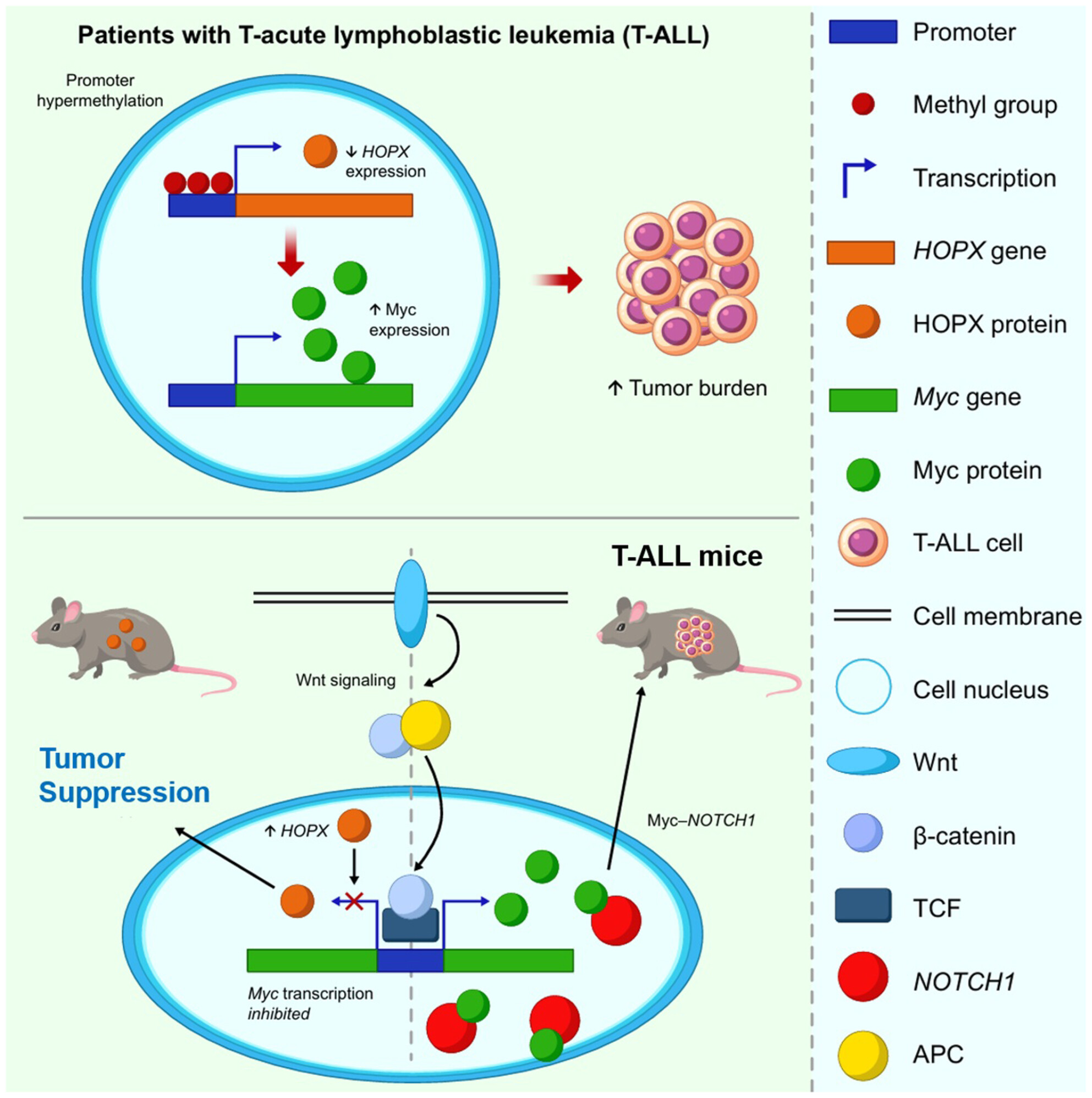
We firstly uncovered a novel link between reduced HOPX expression, its promoter hypermethylation and increased tumour burden in patients with T-ALL, suggesting its tumour-suppressive role. Next, we induced T-ALL by transducing intracellular NOTCH1 (ICN1) into mice with either conditional knock-in at the Rosa26 locus or knockout of Hopx. We found that T-ALL development was markedly accelerated and impeded in backgrounds with low and high Hopx expression respectively. Further analysis revealed Hopx's roles in modulating the Wnt-β-catenin pathway, a pivotal regulator of the downstream Myc signalling involved in T-ALL transformation and progression.
Hydroxy-wybutosine tRNA modifications as indicators of disease progression and therapeutic targets in leukaemia
- Pages: 517-530
- First Published: 10 November 2024
Haematological Malignancy – Clinical
Inequalities in geographic barriers and patient representation in lymphoma clinical trials across England
- Pages: 531-540
- First Published: 27 November 2024
A phase II study of zandelisib in patients with relapsed or refractory indolent non-Hodgkin lymphoma: ME-401-K02 study
- Pages: 541-550
- First Published: 08 January 2025
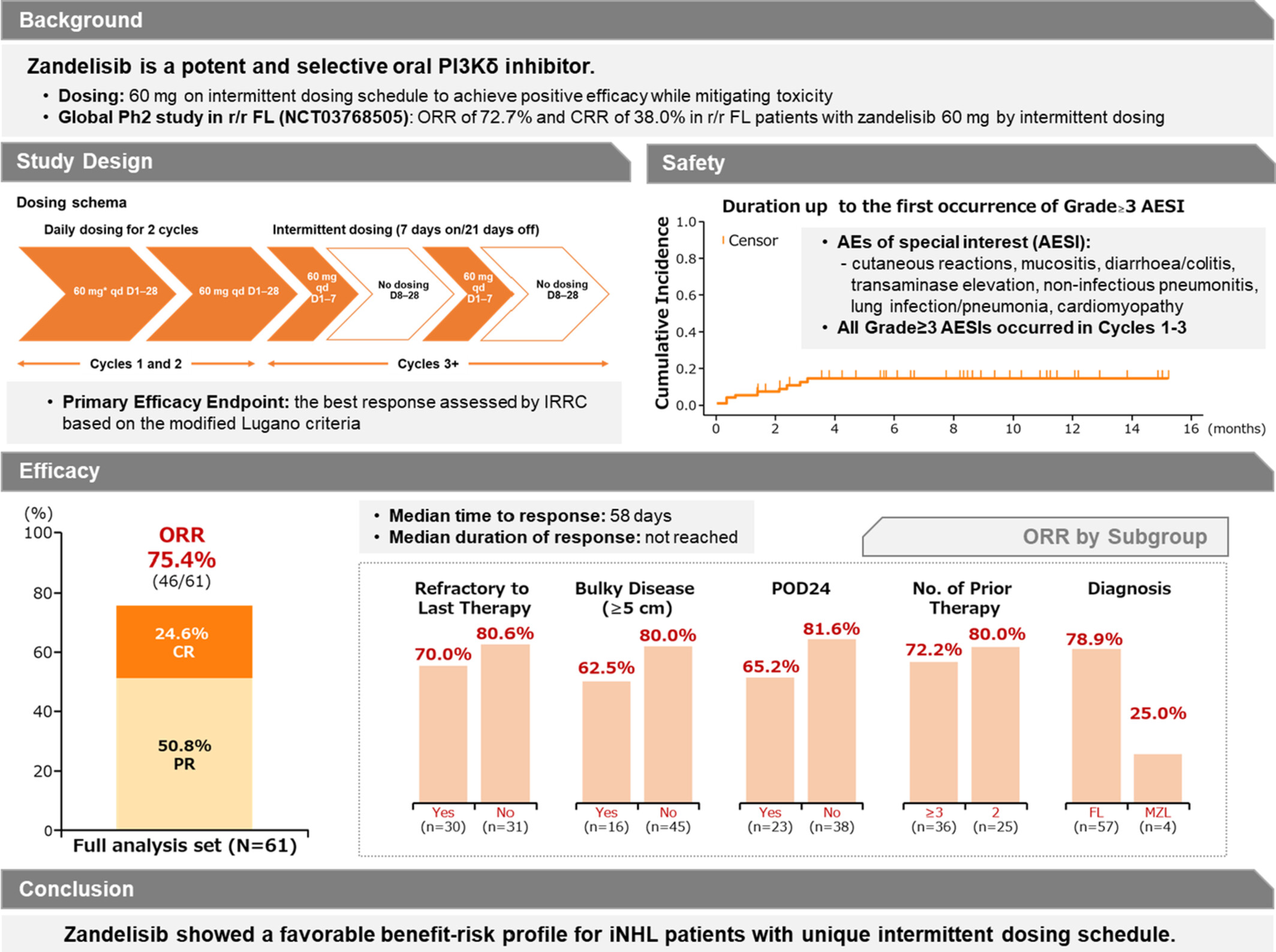
Zandelisib, a selective, potent PI3Kδ inhibitor, demonstrated favourable outcomes in patients with relapsed or refractory follicular lymphoma in a global phase II study. This phase II study evaluated the efficacy and safety of zandelisib for relapsed or refractory follicular lymphoma or marginal zone lymphoma by a unique intermittent dosing schedule to mitigate its on-target toxicities. The objective response rate was 75.4%, with a 24.6% complete response rate. The cumulative incidence of Grade ≥ 3 AEs of special interests reached a plateau after cycle 3. Zandelisib showed a favourable benefit–risk profile for patients with relapsed or refractory indolent non-Hodgkin lymphoma.
SHORT REPORT
Haematological Malignancy – Clinical
CPX-351 +/− gemtuzumab ozogamicin as induction therapy for adult patients with newly diagnosed, favourable-intermediate risk, FLT3-ITD negative, AML: A pilot study
- Pages: 551-555
- First Published: 25 December 2024
ORIGINAL PAPER
Haematological Malignancy – Clinical
Efficacy and safety of bendamustine, rituximab and bortezomib treatment in relapsed/refractory Waldenstrom Macroglobulinaemia: results of phase 2 single-arm FIL-BRB trial
- Pages: 556-564
- First Published: 27 November 2024
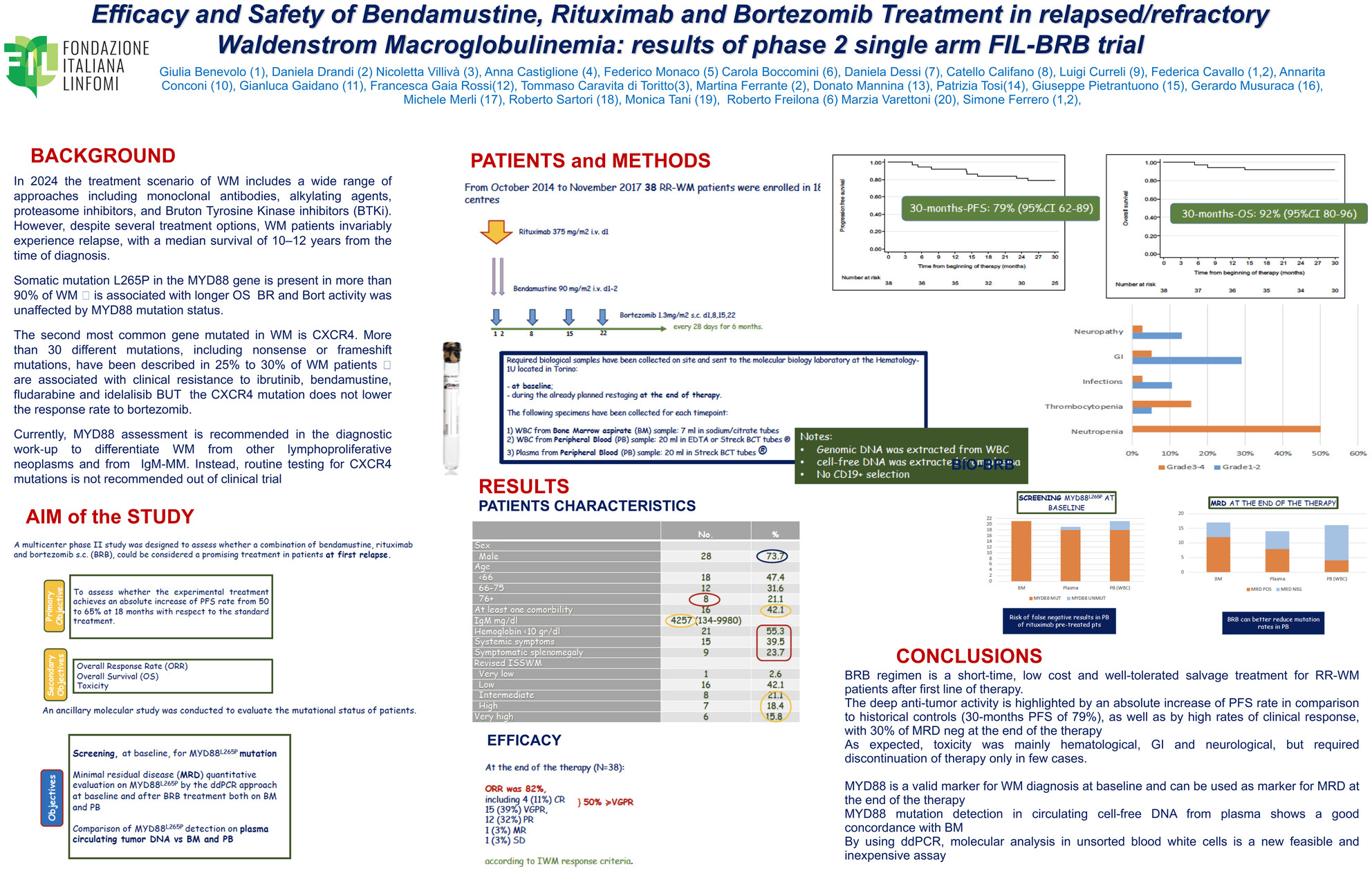
Bortezomib plus rituximab plus bendamustine regimen is a short-time, low-cost and well-tolerated salvage treatment for relapsed refractory Waldenstrom macroglobulinaemia (RR-WM) patients after the first line of therapy. The deep anti-tumour activity is highlighted by an absolute increase of progression-free survival (PFS) rate in comparison to historical controls (30-month PFS of 79%), as well as by high rates of clinical response, with 30% of minimal residual disease (MRD) negativity at the end of the therapy. As expected, toxicity was mainly haematological, gastrointestinal and neurological, but required discontinuation of therapy only in few cases. MYD88 is a valid marker for WM diagnosis at baseline and can be used as marker for MRD at the end of the therapy MYD88 mutation detection in circulating cell-free DNA from plasma shows a good concordance with bone marrow. By using droplet digital polymerase chain reaction (ddPCR), molecular analysis in unsorted blood white cells is a new feasible and inexpensive assay.
Hypomethylating agents for patients with VEXAS without myelodysplastic syndrome: Clinical outcome and longitudinal follow-up of vacuolization and UBA1 clonal dynamics
- Pages: 565-575
- First Published: 13 January 2025
Long-term follow-up of methotrexate and cytarabine in adult patients with Langerhans cell histiocytosis
- Pages: 576-584
- First Published: 20 October 2024
Paediatrics
Elucidating loss-of-function mechanisms of monoallelic EPAS1 mutations underlying congenital hypoplastic anaemia in a paediatric anaemia cohort
- Pages: 585-595
- First Published: 29 November 2024
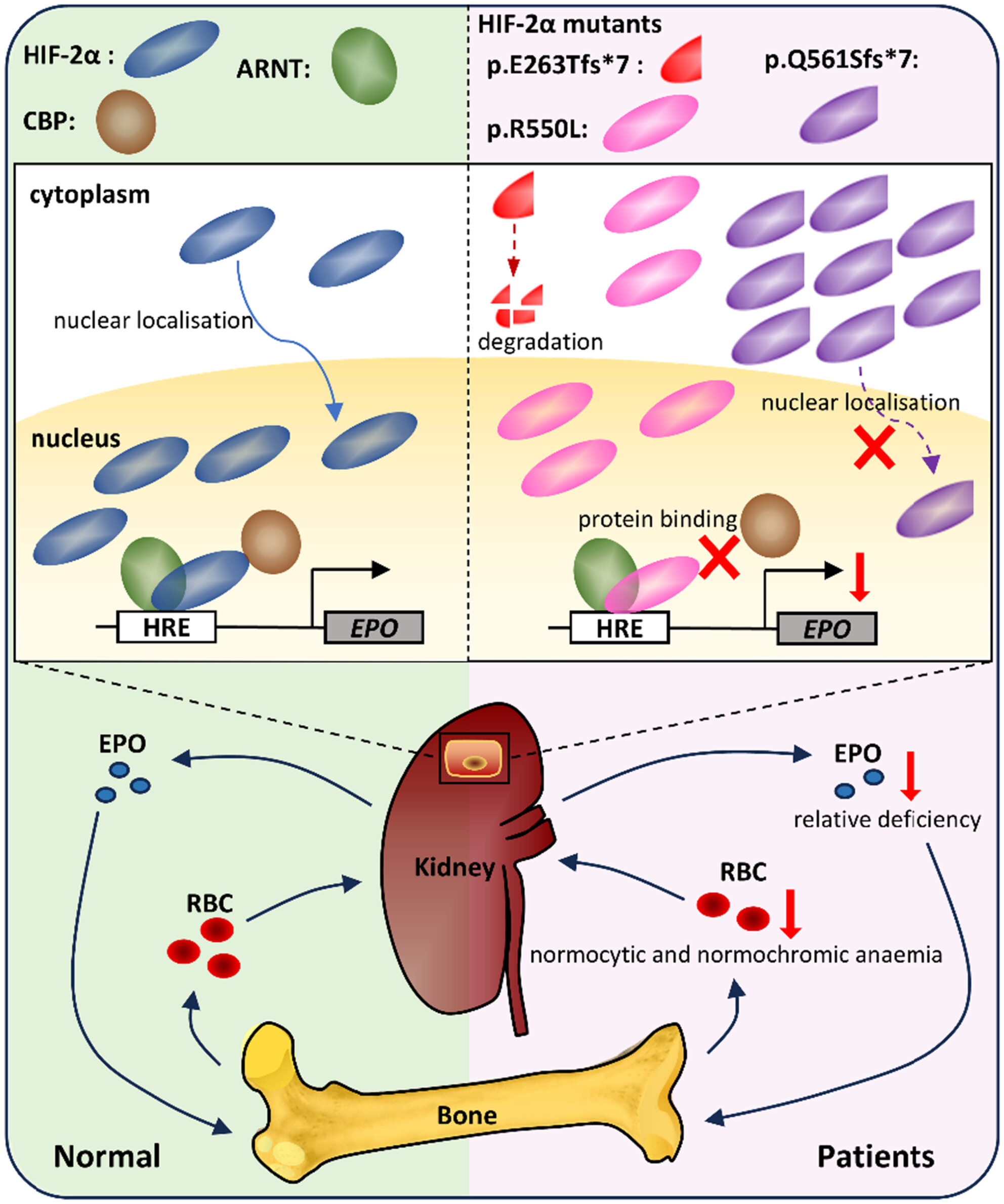
HIF-2α, encoded by EPAS1, is the main transcriptional factor of EPO production in the kidney, which maintains the dynamic balance of erythropoiesis. Herein, three monoallelic EPAS1 variants from three unrelated families were identified in a paediatric anaemia cohort. Highly consistent clinical phenotypes with normocytic and normochromic anaemia, reticulocytopenia and relative deficiency of serum EPO were revealed in the patients. The HIF-2α mutants showed defects in steady-state protein abundance, nuclear localisation and binding with co-activator, which lead to impaired EPO transcriptional activation. These findings indicated monoallelic EPAS1 variants cause congenital hypoplastic anaemia depending on EPO production in a loss-of-function mechanism.
AI
Development and validation of a deep learning model for morphological assessment of myeloproliferative neoplasms using clinical data and digital pathology
- Pages: 596-606
- First Published: 10 December 2024
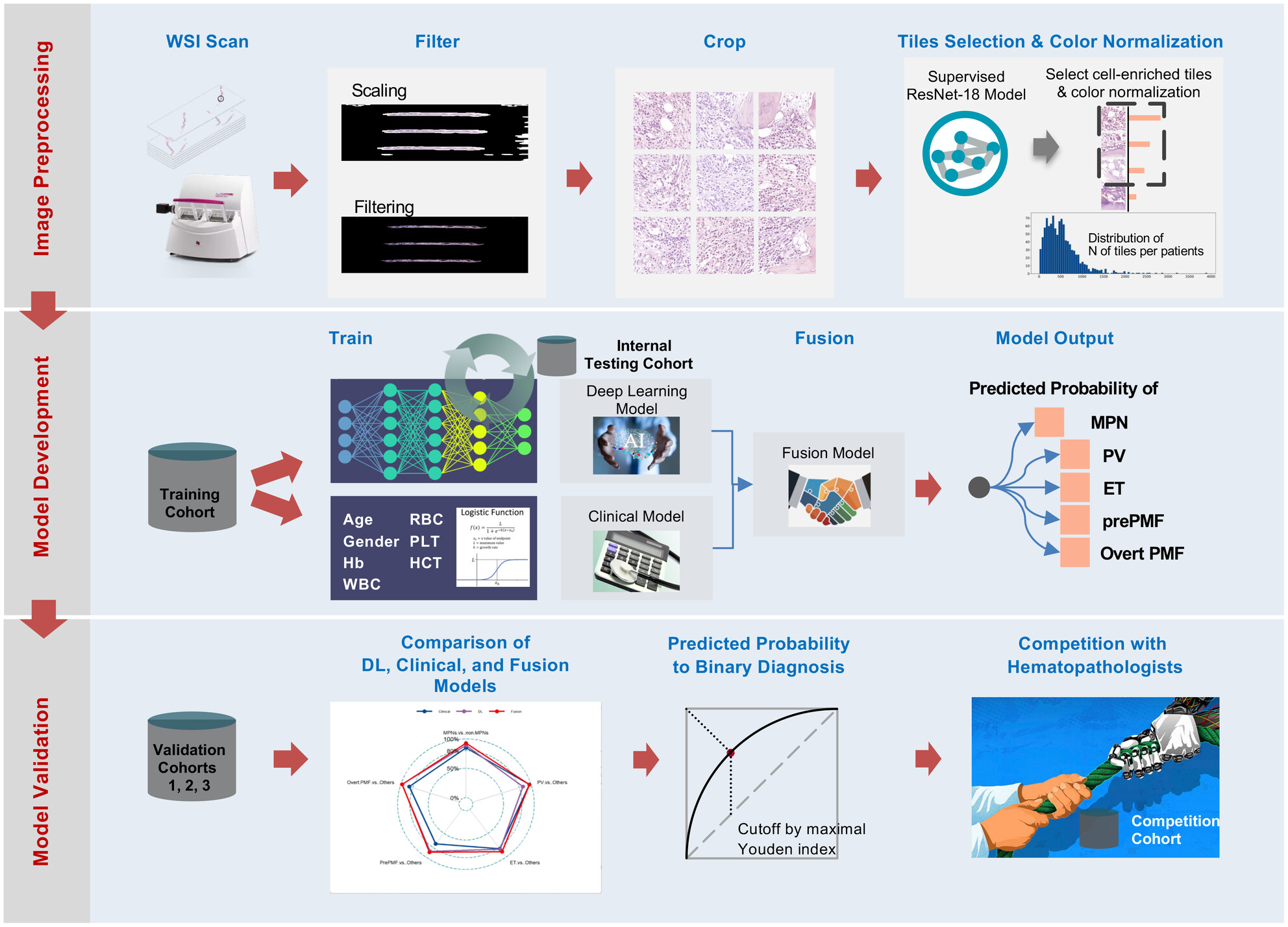
The subjectivity of morphological assessment and the overlapping pathological features of different subtypes of myeloproliferative neoplasms (MPNs) make accurate diagnosis challenging. To improve the pathological assessment of MPNs, we took both haematoxylin–eosin staining BM whole-slide images (WSI) and clinical features from 1051 MPN and non-MPN patients from seven hospitals in China, and developed artificial intelligence-assisted model based on the combination of WSI and clinical parameters for pathological diagnosis. Our model demonstrated well performance in distinguishing MPNs from non-MPN conditions and MPN subtypes. The diagnostic accuracies surpassed those of junior haematopathologists and were equivalent to seniors, providing a new perspective on the comprehensive utilization of deep learning models in MPN morphological assessment.
Transplantation and Cellular Therapy
Autologous stem cell transplantation for multiple myeloma patients whose myeloma-defining event was SLiM
- Pages: 607-614
- First Published: 29 November 2024
Humanized anti-CD25 monoclonal antibody replaces methotrexate as acute graft-versus-host disease prophylaxis in haploidentical allogeneic haematopoietic stem cell transplantation
- Pages: 615-627
- First Published: 22 December 2024
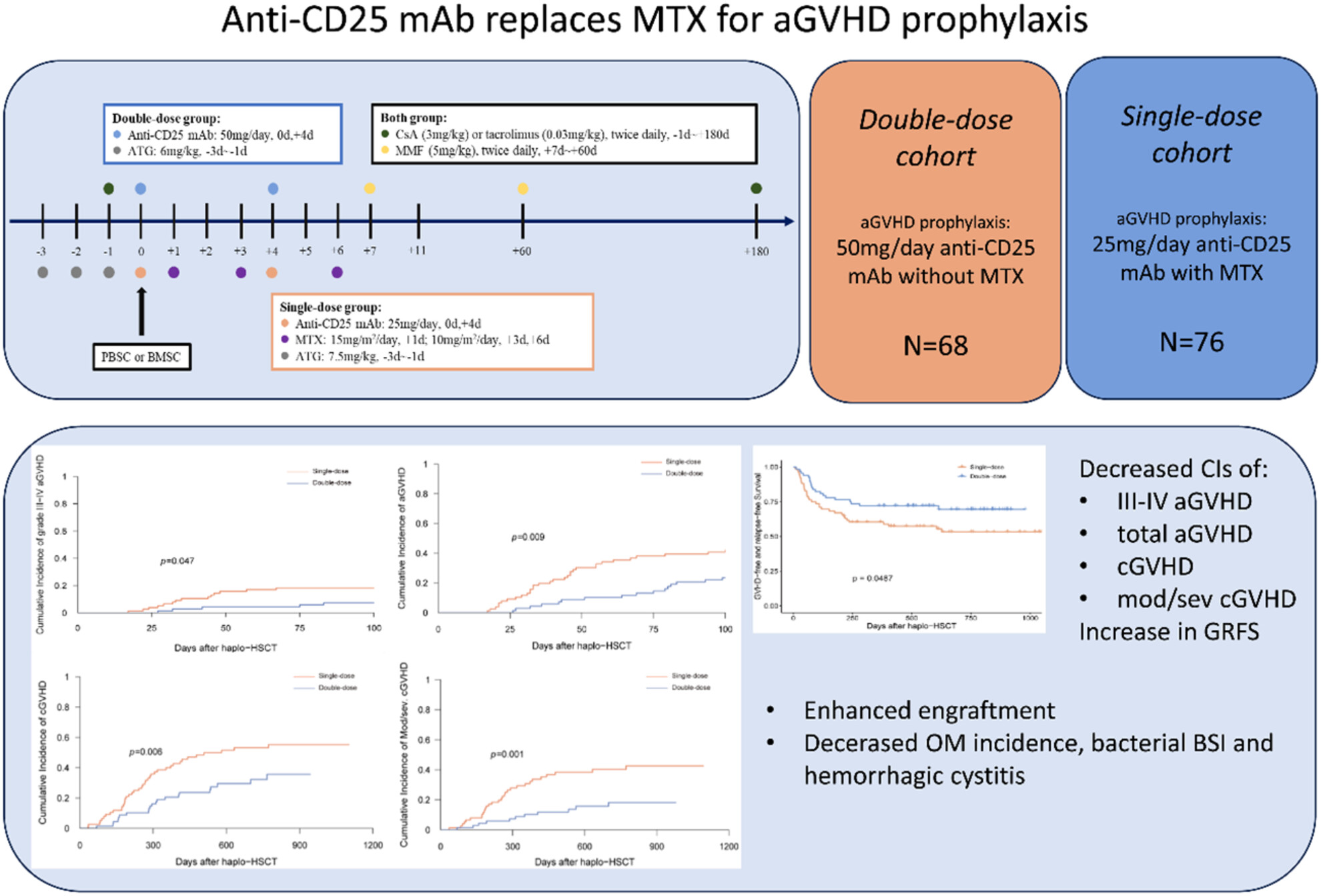
This study investigates the efficacy of anti-CD25 monoclonal antibody (mAb) as a potential MTX alternative. Participants were divided into two cohorts: a single-dose group (25 mg/day anti-CD25 mAb with MTX) and a double-dose group (50 mg/day anti-CD25 mAb without MTX). Herein, we demonstrated that a higher dose of humanized anti-CD25 mAb without MTX can successfully reduce CI of total aGVHD by day 100, grade III–IV aGVHD by day 100, 1-year cGVHD as well as mod/sev cGVHD. Furthermore, this regimen produced statistically significant outcomes in enhancing engraftment, reducing and alleviating OM incidence, diminishing infection rates, mitigating treatment-induced mucosal damage and improving GRFS in patients. These findings suggest that a double-dose anti-CD25 mAb regimen without MTX is a promising strategy for aGVHD prophylaxis in haplo-HSCT.
mRNA-laden lipid nanoparticle-enabled humanized CD19 CAR-T-cell engineering for the eradication of leukaemic cells
- Pages: 628-643
- First Published: 06 January 2025
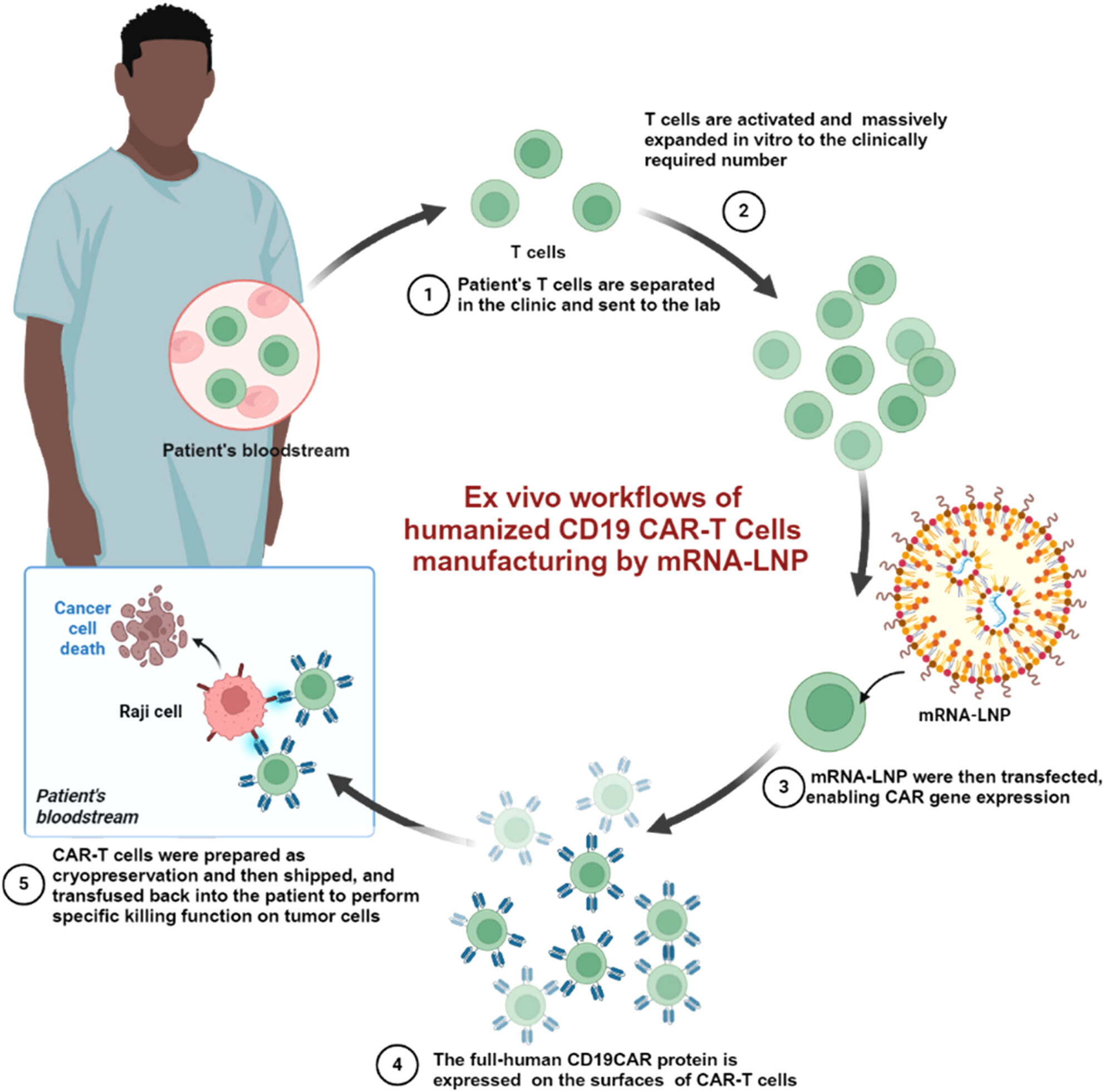
We introduce a novel CAR-T-cell engineering strategy utilizing mRNA-laden lipid nanoparticles (mRNA-LNPs) to address the challenges of viral vector-based approaches, including insertional mutagenesis and high production costs. Humanized CAR mRNA targeting CD19 was encapsulated into LNPs using microfluidic mixing, achieving efficient transfection and robust CAR expression. Engineered CAR-T cells exhibited potent cytotoxicity against leukaemic cells in vitro, demonstrated increased cytokine secretion and enhanced tumour killing in co-culture systems. In vivo studies in NSG mice with Raji cell engraftment confirmed significant tumour regression and prolonged survival, highlighting mRNA-LNP technology as a safer, scalable alternative for CAR-T therapy.
Brexucabtagene autoleucel in-vivo expansion and BTKi refractoriness have a negative influence on progression-free survival in mantle cell lymphoma: Results from CART-SIE study
- Pages: 644-651
- First Published: 22 December 2024
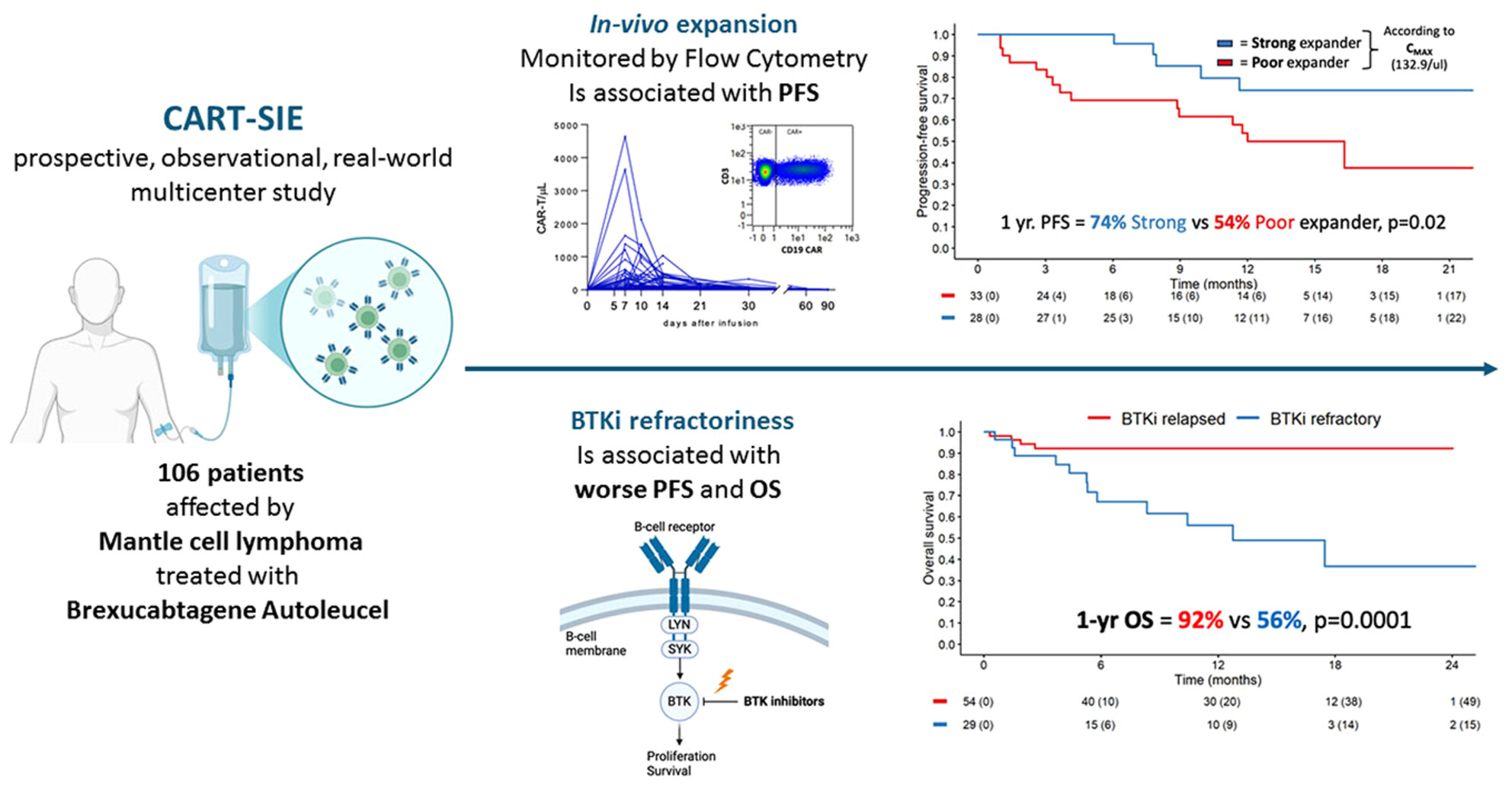
In this prospective, observational, real-world, multicentre study, we evaluated 106 patients affected by mantle cell lymphoma. The patients were treated with the anti-CD19 CAR T-cell therapy Brexucabtagene autoleucel (brexu-cel). Our study corroborated the association between in-vivo CAR T-cell expansion and progression-free survival (PFS). Moreover, refractoriness to Bruton tyrosine-kinase inhibitors (BTKi) was identified as a negative prognostic factor.
SHORT REPORT
Platelets, Thrombosis and Haemostasis
Avatrombopag in adults with immune thrombocytopenia: A multicentre real-life observational study in Madrid, Spain (AVAMAD study)
- Pages: 652-656
- First Published: 05 January 2025
ORIGINAL PAPER
Platelets, Thrombosis and Haemostasis
Fibrinogen genotypes and their impact on recurrence of venous thromboembolism and family history: A prospective population-based study
- Pages: 657-665
- First Published: 19 January 2025
Imaging flow cytometry as a novel approach for the diagnosis of heparin-induced thrombocytopenia
- Pages: 666-674
- First Published: 10 December 2024
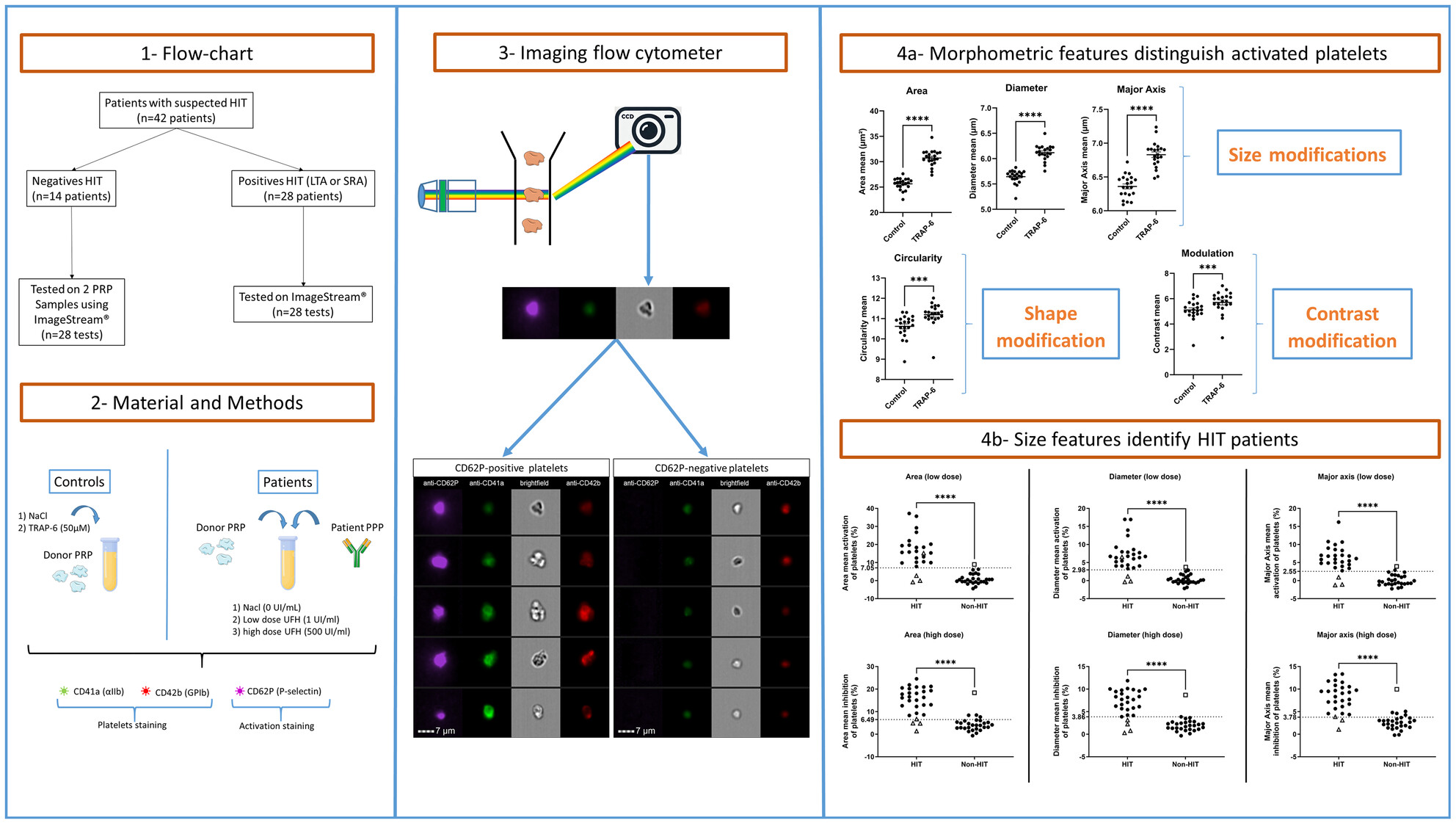
Imaging flow cytometry (IFC) combines the advantages of flow cytometry (FC) and microscopy to provide detailed morphological insights into platelets. In this study, we evaluated the performance of morphometric features for heparin-induced thrombocytopenia (HIT) diagnosis. A total of 42 patients with suspected HIT were included: 28 HIT-positive patients (tested once) and 14 HIT-negative patients (tested twice). Morphometric features such as size, shape and contrast showed significant changes between resting platelets (negative control, NaCl) and TRAP-6-activated platelets (positive control), enabling the detection of platelet activation with IFC. To diagnose HIT, donor platelet-rich plasma was mixed with patient platelet-poor plasma in the presence of increasing concentrations of heparin. Subsequently, platelets were labelled with CD62P, an internal marker of platelet activation. Measurements of area, diameter and major axis features reliably identified HIT-positive patients, with performance levels comparable to those of CD62P expression. This study highlights that IFC is a label-free, robust and efficient method for detecting platelet activation, offering a promising alternative to conventional functional assays for HIT diagnosis.
Inhibition of FcRn with rozanolixizumab in adults with immune thrombocytopenia: Two randomised, double-blind, placebo-controlled phase 3 studies and their open-label extension
- Pages: 675-688
- First Published: 18 November 2024
Haemoglobinopathies
Memantine treatment in sickle cell disease: A 1-year study of its effects on cognitive functions and neural processing
- Pages: 689-702
- First Published: 05 November 2024
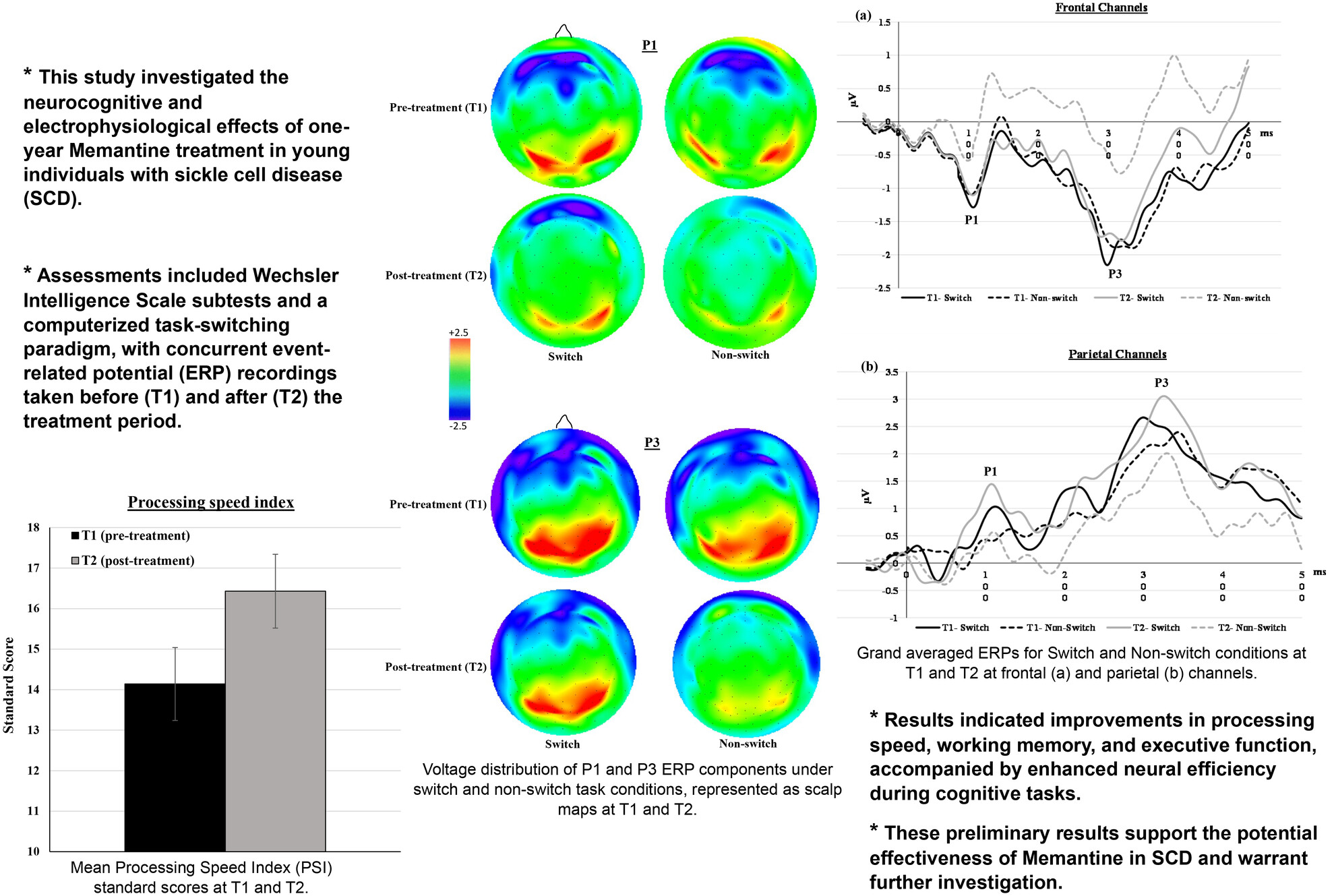
This study investigated the neurocognitive and electrophysiological effects of 1-year memantine treatment in young individuals with sickle cell disease (SCD). Assessments included Wechsler Intelligence Scale subtests and a computerized task-switching paradigm, with concurrent event-related potential (ERP) recordings taken before (T1) and after (T2) the treatment period. Results indicated improvements in processing speed, working memory and executive function, accompanied by enhanced neural efficiency during cognitive tasks. These preliminary results support the potential effectiveness of memantine in SCD and warrant further investigation.
Impact of HbE mutation on the clinical severity of HbH disease: A multicentre study from Thailand
- Pages: 703-712
- First Published: 30 October 2024
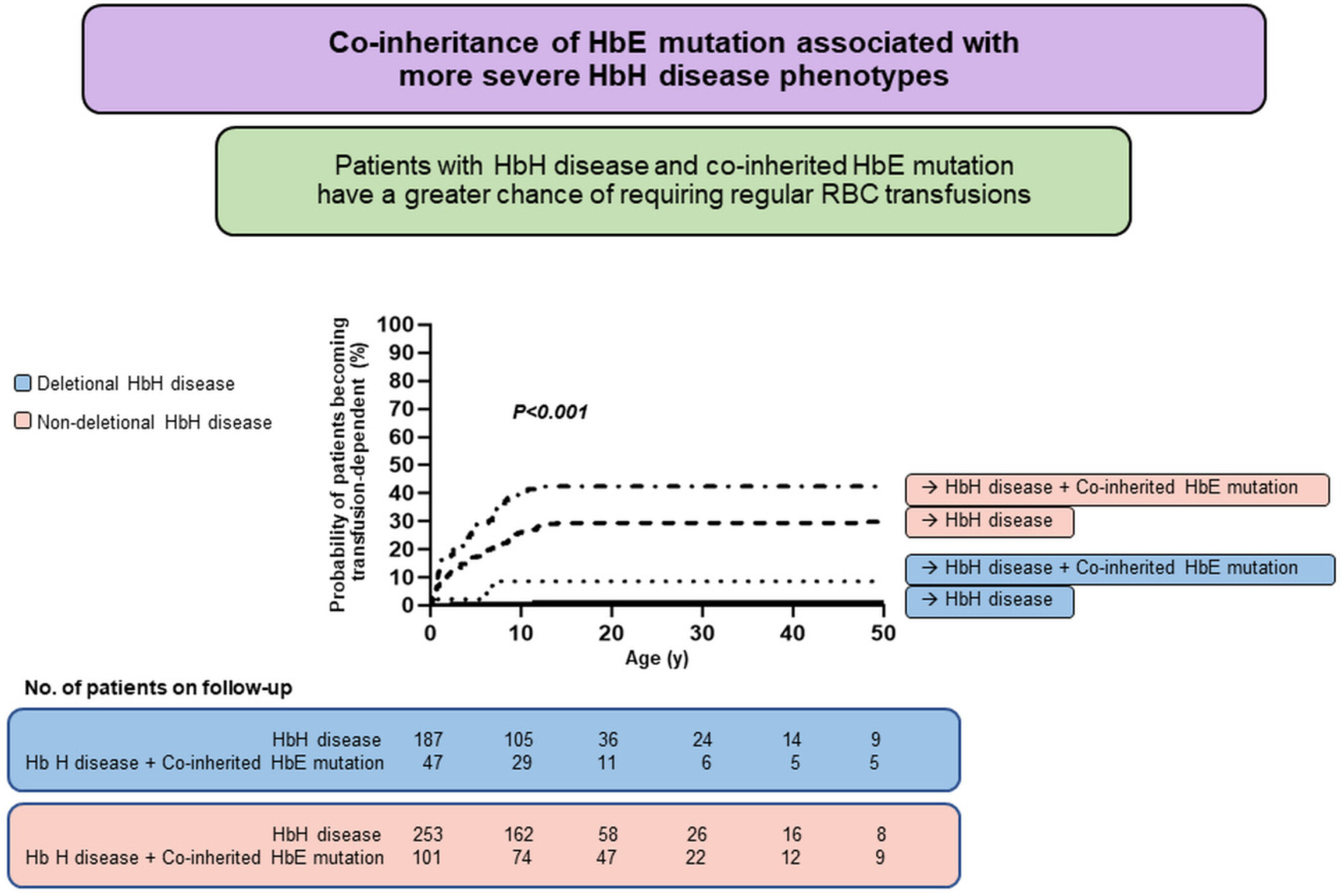
Haemoglobin H (HbH) disease with co-inheritance of HbE mutation is frequently found in Southeast Asia. This large multicentre study with a total of 588 enrolled patients demonstrated that co-inheritance of HbE mutation was associated with a higher rate of on-demand or chronic transfusions compared to those with HbH disease alone. The impact of HbE co-inheritance was mainly observed in patients with non-deletional HbH disease. The graph shows the proportion of patients in each diagnosis group becoming transfusion-dependent at different ages.
Impact of hydroxycarbamide treatment on the whole-blood transcriptome in sickle cell disease
- Pages: 713-720
- First Published: 17 November 2024
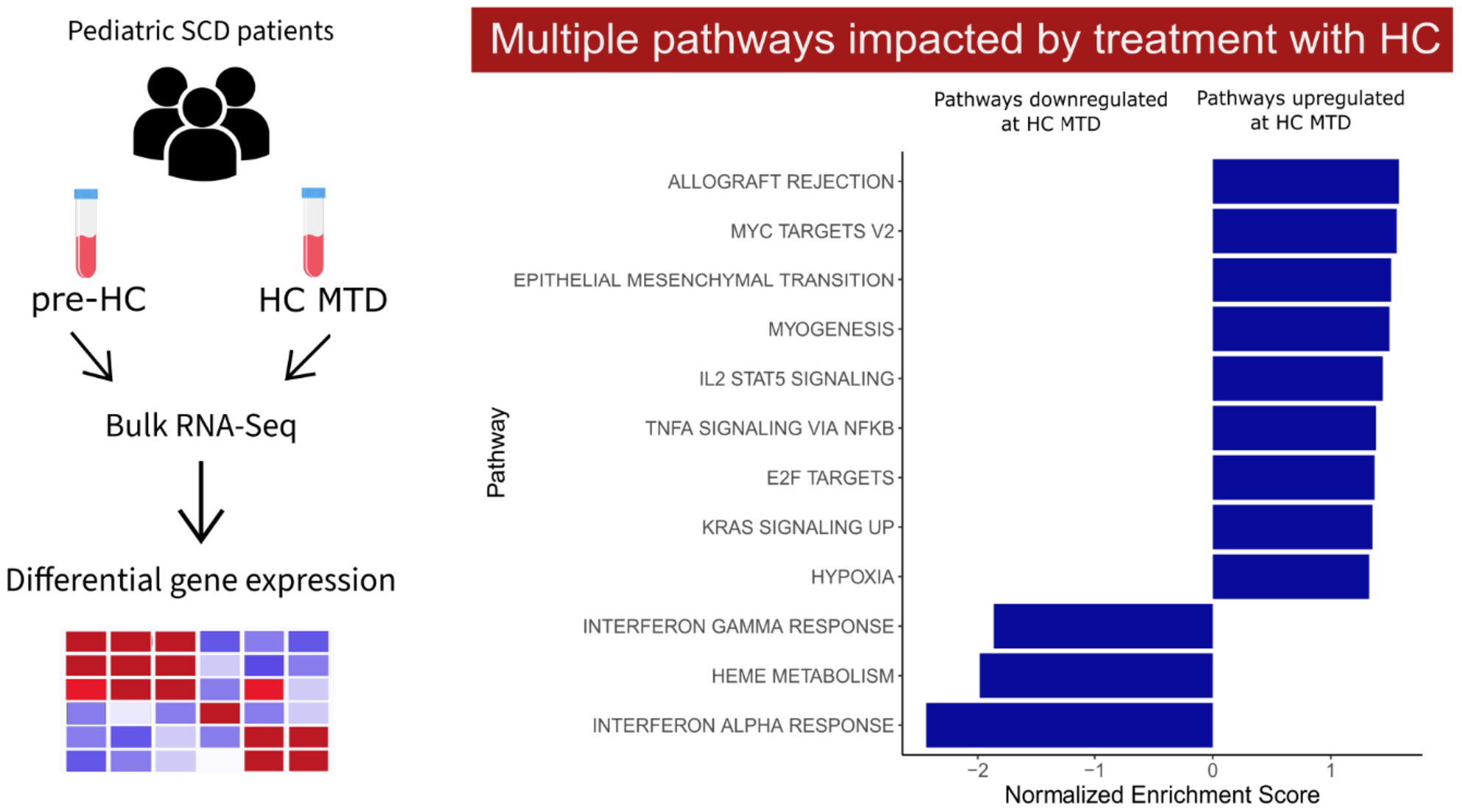
Hydroxycarbamide (HC) is the most widely used therapeutic for individuals with sickle cell disease (SCD). HC's benefits are primarily associated with its ability to induce foetal haemoglobin (HbF); this limited view of HC's therapeutic potential may lead to its discontinuation when a modest amount of HbF is induced. Here, we performed bulk RNA-Seq on whole blood samples collected from 25 paediatric patients with SCD to identify genes and pathways affected by treatment with HC. Pathways related to haeme metabolism, interferon-gamma response, and interferon-alpha response were significantly downregulated at HC MTD relative to the matched pre-HC samples. Pathways linked with IL2-STAT5 signalling and TNFα signalling via NF-Kβ were observed to be up-regulated at HC MTD. These results pave the way for an improved understanding of the HbF induction-independent benefits of HC.
SHORT REPORT
Red Cells
EGLN1 mutations in Cis can induce congenital erythrocytosis with thromboses by increasing protein instability
- Pages: 721-725
- First Published: 02 January 2025
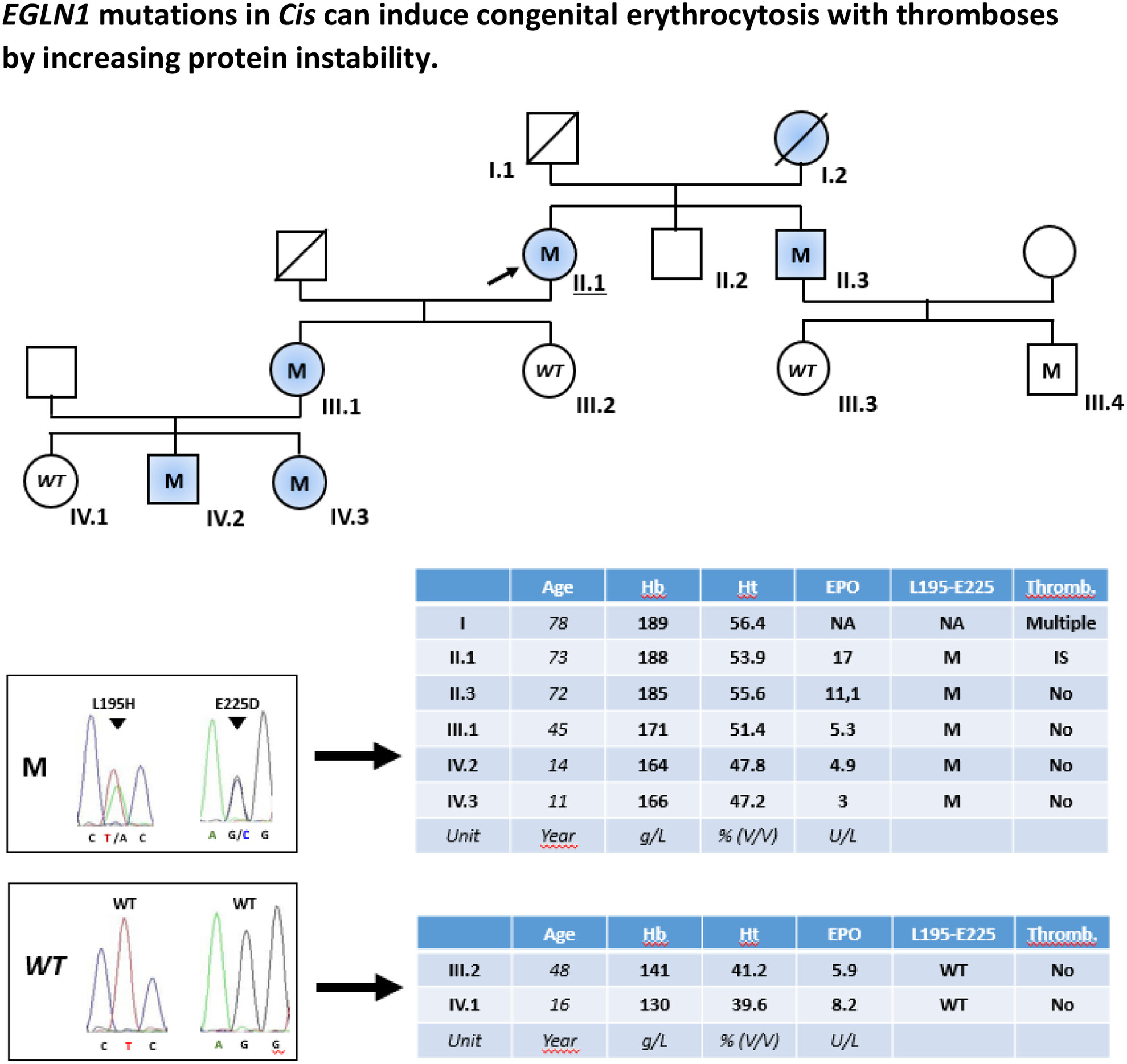
Description of a Type 3 erythrocytosis informative family over four generations comprising five erythrocytic members. These five members harbour two unreported prolyl hydroxylase domain 2 (PHD2) mutations L195H and E225D, lying within the catalytic domain. These mutations affect PHD2 stability, which is involved in the O2-sensing pathway. Structural, biochemical and functional studies allow us to depict each mutation effect. Erythrocytosis ranges from asymptomatic to symptomatic. Proband experienced ischaemic stroke: She was an old smoking woman without any other genetic causes except PHD2 mutations. Clinical effect of these mutations can be inapparent, as shown in one case, maybe due to his genetic background.
ORIGINAL PAPER
Transfusion
Frequencies and causes of ABO-incompatible red cell transfusions in France, Germany and the United Kingdom
- Pages: 726-734
- First Published: 30 October 2024
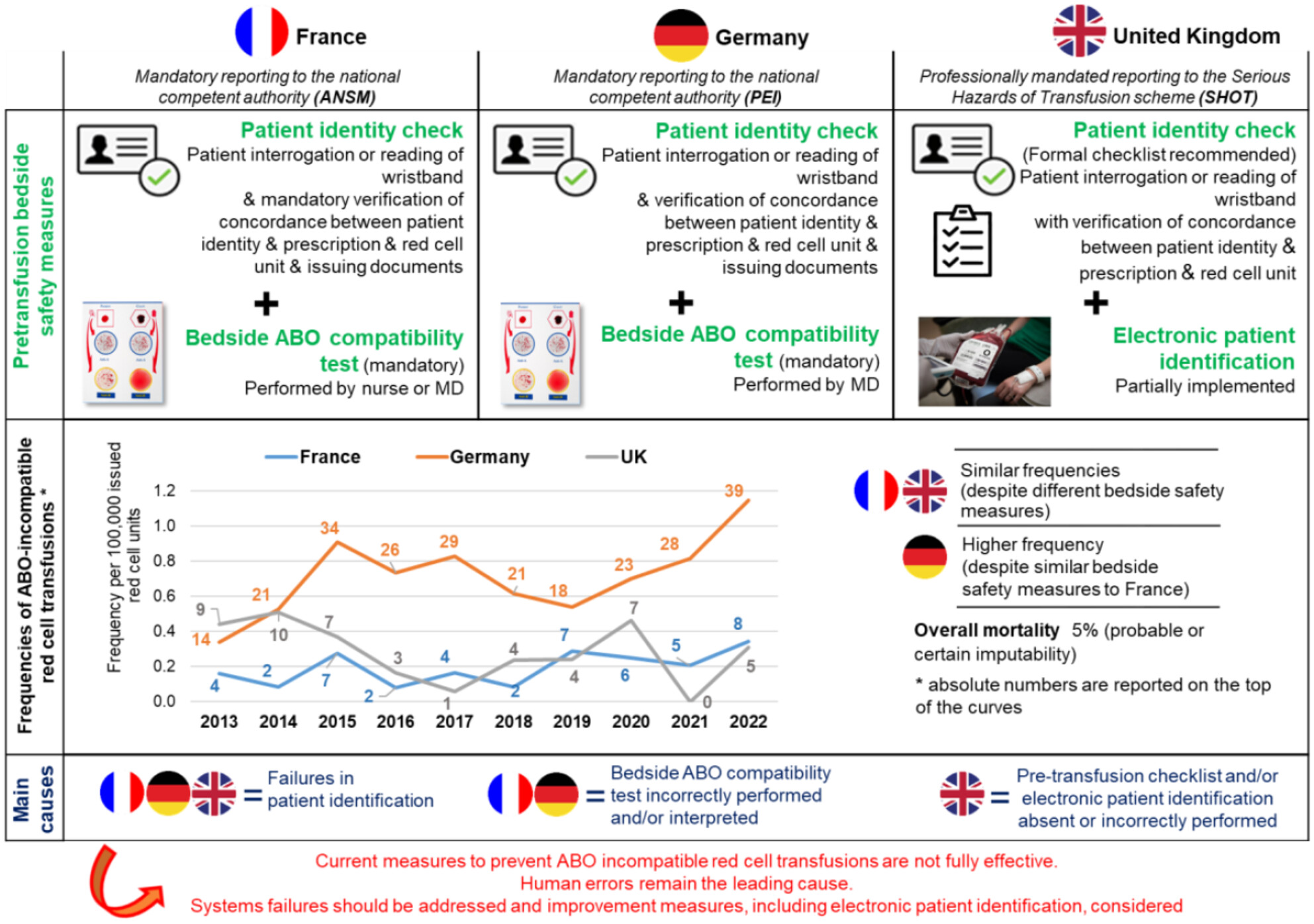
In France, Germany and the United Kingdom, different bedside safety measures are implemented to prevent ABO-incompatible red cell transfusion (ABO-it). In France and Germany, in addition to the identity check, a bedside ABO compatibility test is mandatory. In the UK, the identity check is performed with or without electronic patient identification (ePID). From 2013 to 2022, similar ABO-it frequencies were observed in France and in the UK despite different bedside safety measures, whereas a higher frequency was reported for Germany in spite of similar bedside safety policies as in France. In the three countries, ABO-it mainly resulted from failures in bedside pretransfusion safety policies, erroneous patient identification and transfusion of a red cell unit intended for another patient. Current safety measures do not fully prevent ABO-it with human errors remaining the leading cause. Further implementation of effective ePID systems across the entire transfusion process applied by well-trained personnel should be considered.
Haematopoiesis
Comparative study of the diversity of amino acids on human leucocyte antigen class II molecules in patients with acquired aplastic anaemia
- Pages: 735-748
- First Published: 13 November 2024
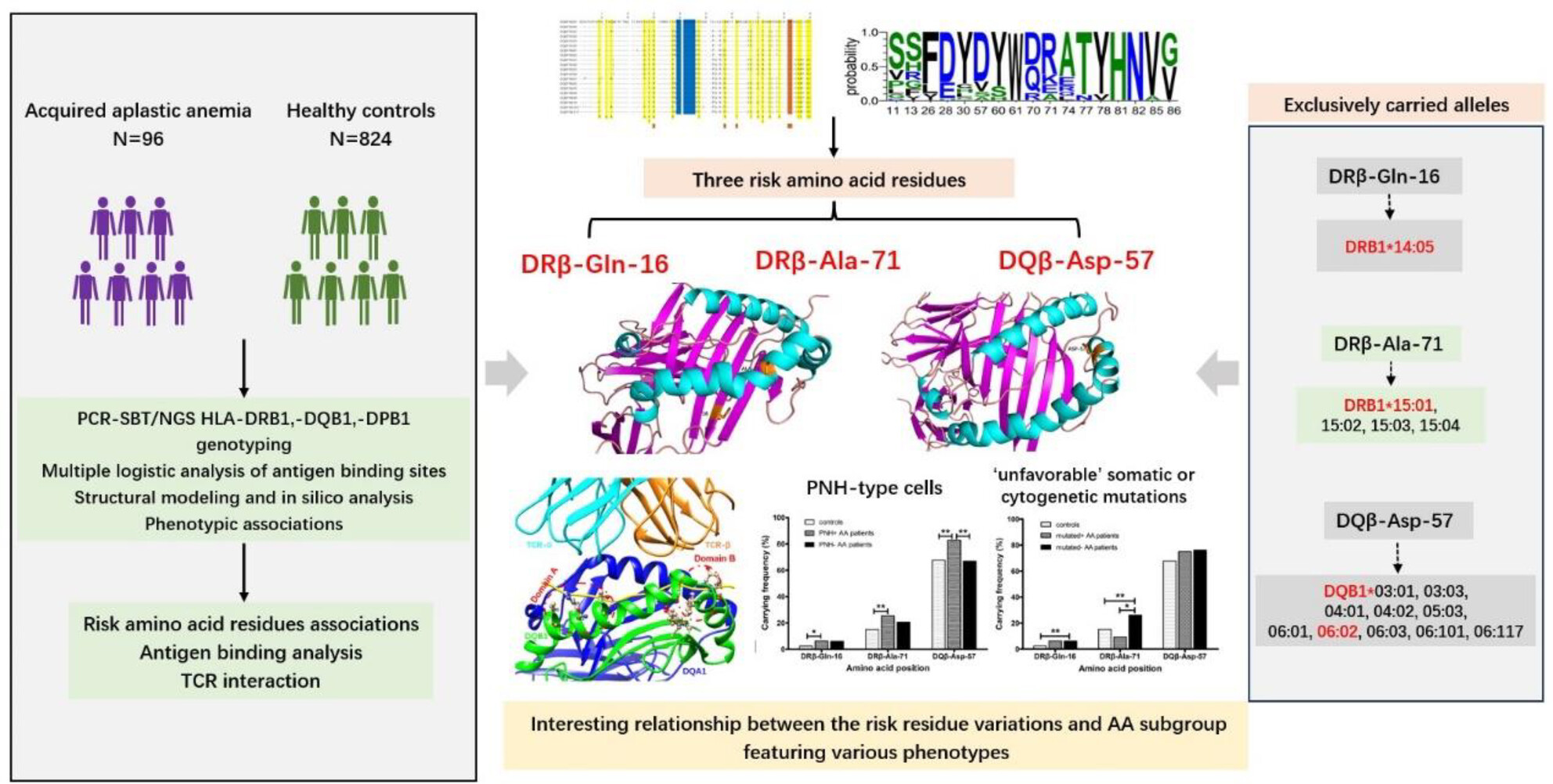
As an immunogenetic disease susceptibility factor, human leucocyte antigen (HLA) class II loci involve in the pathophysiology of acquired aplastic anaemia (AA) by regulating the immune response and autoreactive T-cell-mediated haematopoietic cell death. Distinctive amino acid configurations encoded by the at-risk HLA alleles enriched in AA patients impact the immune presentation of the peptide repertoire derived from haematopoietic stem/progenitor cells. DRβ-Ala-71, DQβ-Asp-57 and DRβ-Gln-16 are discovered as crucial risk amino acid residues in HLA II class proteins on the onset of AA, as well as associated with paroxysmal nocturnal haemoglobinuria (PNH)-type cells and pathological somatic or cytogenetic mutations. DRβ-Ala-71 and DQβ-Asp-57 within the antigen-binding groove interacting with a more variable antigenic segments, may impact the repertoire of peptides presented, influence the interface HLA-antigen-T-cell receptor β (TCR β).
LETTER TO THE EDITOR
Biochemical screening of glucose-6-phosphate dehydrogenase deficiency in borderline cases: Complementary inputs of standardization enzymes and comparison with genetic status
- Pages: 749-752
- First Published: 06 January 2025
Clinical and genetic profiles and outcomes of allogeneic haematopoietic stem cell transplantation in secondary myelodysplastic syndrome following aplastic anaemia
- Pages: 753-757
- First Published: 21 October 2024
JAK2 is a critical therapeutic target in VEXAS syndrome treated with ruxolitinib
- Pages: 758-762
- First Published: 15 January 2025
Impact of body mass index on outcomes of multiple myeloma patients undergoing upfront autologous stem cell transplant
- Pages: 763-765
- First Published: 28 November 2024
Increased relative eosinophil counts portend neck oedema after chimeric antigen receptor-T therapy
- Pages: 766-768
- First Published: 06 January 2025
Increasing the dose of recombinant human thrombopoietin can enhance platelet engraftment after allogeneic haematopoietic stem cell transplantation: A NICHE cohort study
- Pages: 769-772
- First Published: 15 December 2024
Long-term remission of TP53-mutated therapy-related acute myeloid leukaemia following allogeneic stem cell transplantation in a heart transplant recipient: A case report and literature review
- Pages: 773-776
- First Published: 30 December 2024
Identification of a GFI1B variant associated with abnormal platelet function and normal platelet count
- Pages: 777-780
- First Published: 23 December 2024
Exhaled breath analysis during vaso-occlusive events in sickle cell disease
- Pages: 781-784
- First Published: 15 December 2024
COMMENTARY
Targeting RNA modifications in leukaemia: Epitranscriptomic drugs are the new kids on the block
- Pages: 785-787
- First Published: 10 November 2024
A successful clinical trial ecosystem offers equal opportunities for all citizens
- Pages: 788-789
- First Published: 28 November 2024
Dissecting the genomic traits and clinical course of secondary myelodysplastic syndrome following aplastic anaemia: A milestone
- Pages: 790-791
- First Published: 14 November 2024
Methotrexate and cytarabine in adult LCH: High risk, high reward and maintenance free?
- Pages: 792-794
- First Published: 13 November 2024
From old to new: Repurposed drugs in the battle towards curing sickle cell disease
- Pages: 795-797
- First Published: 20 November 2024
To err is human … so how can we prevent all ABO-incompatible transfusions?
- Pages: 798-799
- First Published: 04 December 2024
Drafting a blueprint for designing successful clinical trials in clonal haematopoiesis
- Pages: 800-802
- First Published: 09 December 2024




